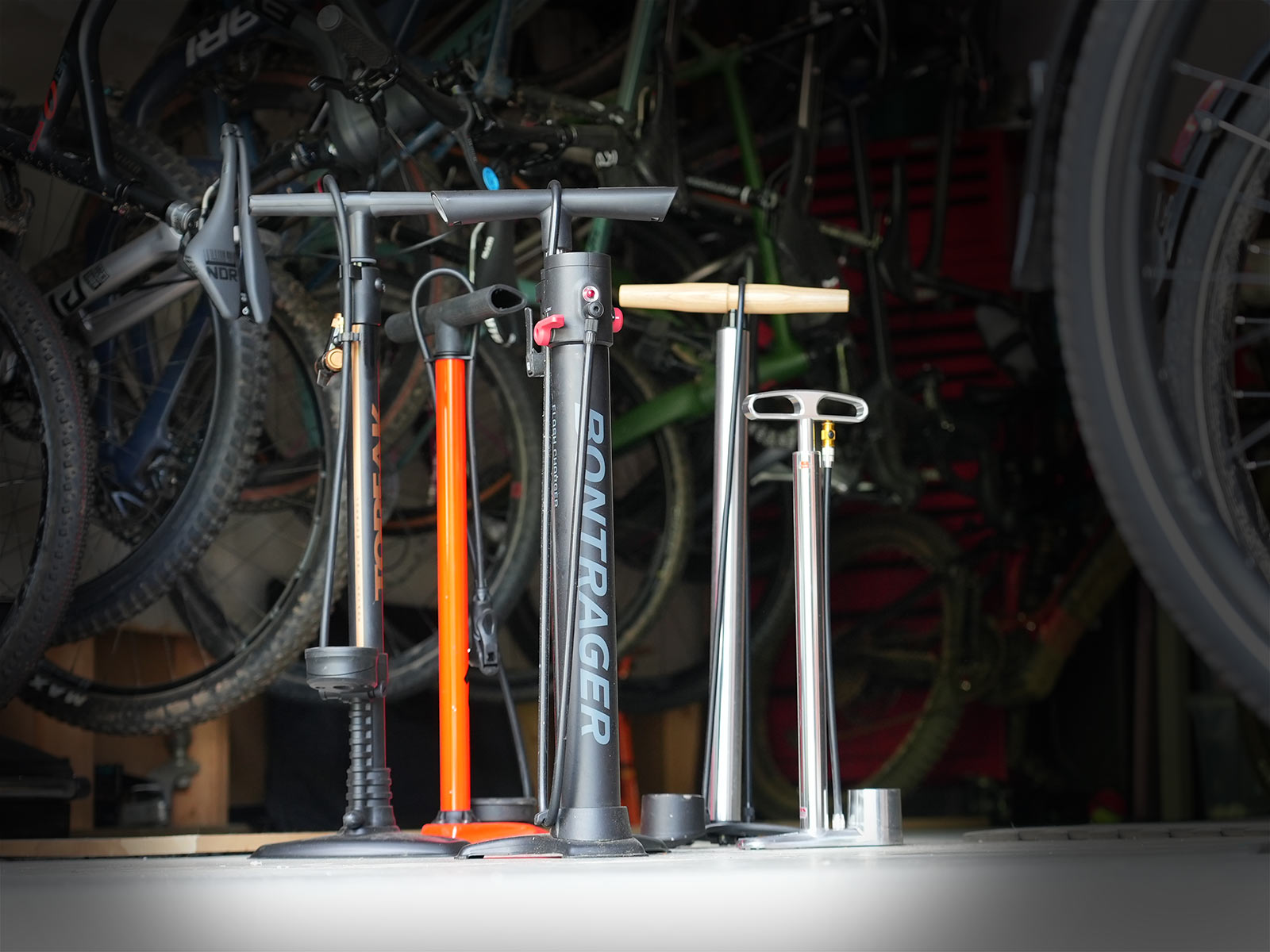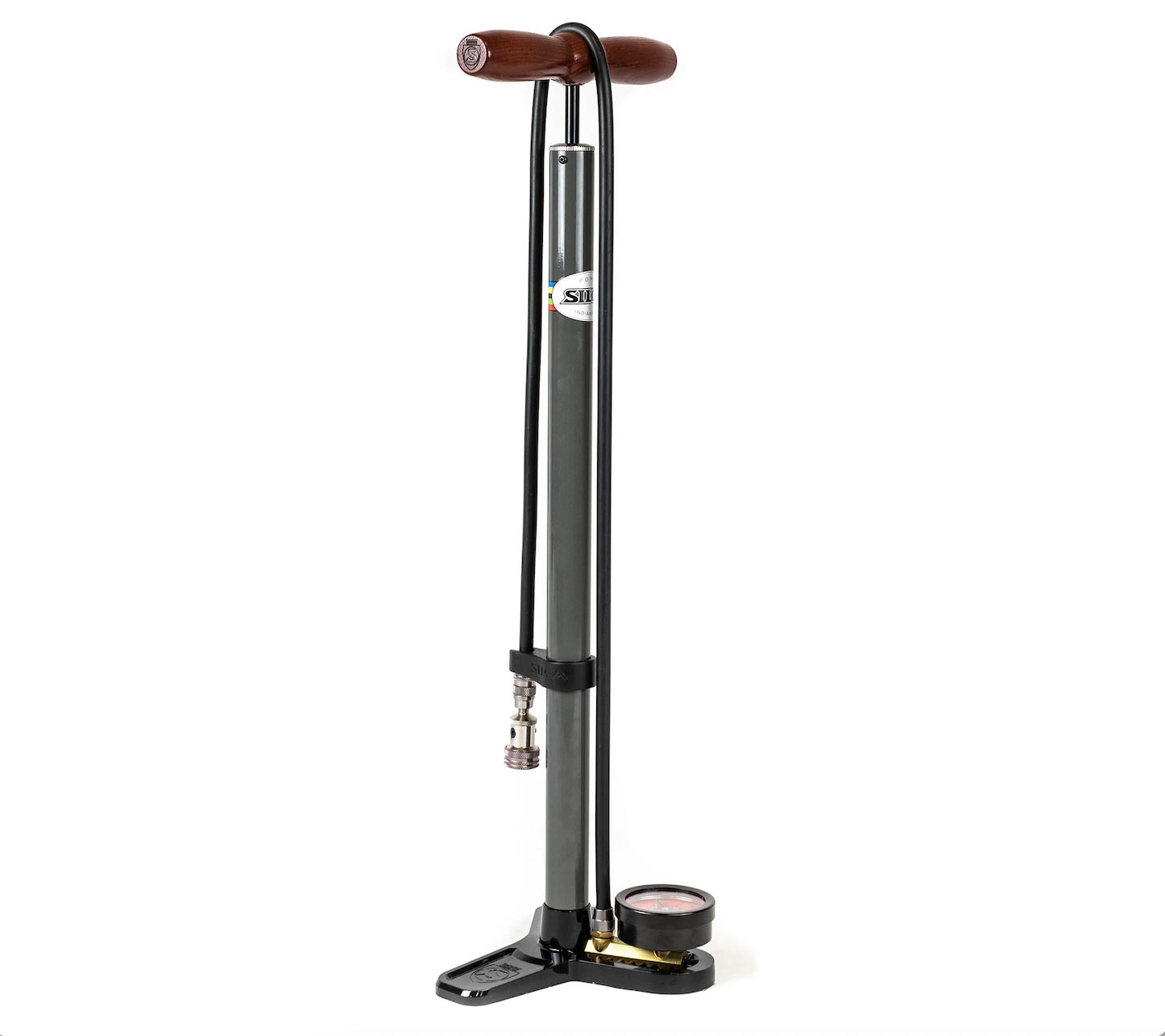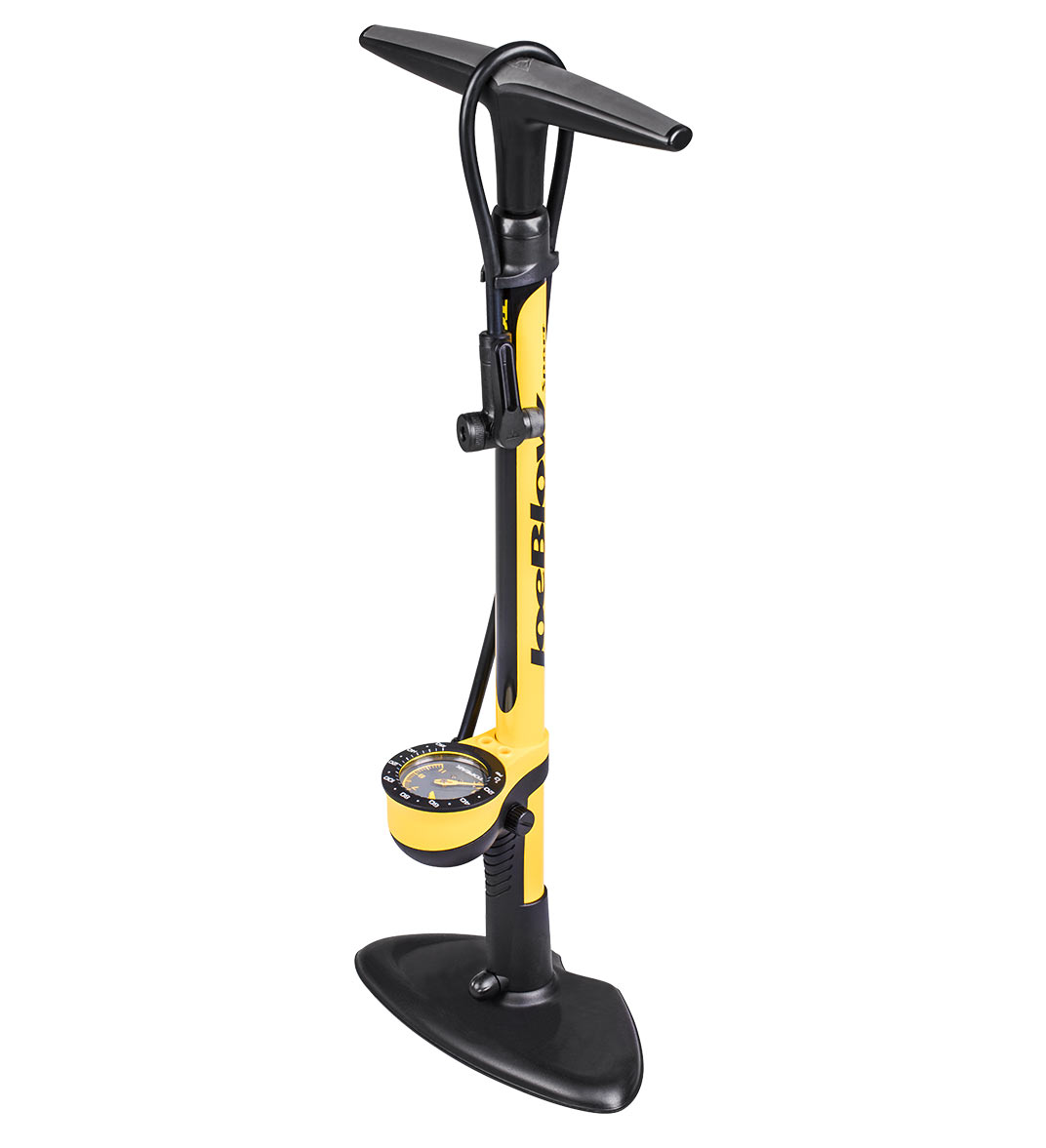No matter what kind of cyclist you are—roadie, mountain biker, cyclocross superstar, gravel grinder, city commuter, or completely new rider—you’re going to need a bike pump. It’s a non-negotiable. And while it seems like a simple piece of equipment, a pump can make or break your ride.
Before you head out the door for a ride, you’re going to want to ensure that your tires are pumped to the right pressure -PSI- for the type of ride that you’re doing. There are thousands of options when it comes to buying a bike pump, from mini-pumps with digital gauges to high-pressure bike pumps with extra chambers for mounting a tubeless tire to the rim on the first try.
Here, we’re simplifying the list to bring you the options for the best bicycle floor pump to suit your riding needs:
Best Overall: Silca Pista Plus
When it comes to bike pumps, longtime cyclists generally agree that the Silca Pista Plus Floor Pump is almost impossible to beat. While Silca has some other products in their lineup, the company is really all about the perfect bike pump and has been for more than a century. Silca is also committed to not making major changes to their products, meaning that replacement parts will continue to work on your decades-old pump. That’s part of the reason for the hefty price tag: Buy one, and you have a pump for life.
Originally designed in 1962, the Silca Pista Plus is made with steel for the barrel, and ash wood for the highly polished handle. The plunger is leather, which actually works better over time rather than wearing out like the rubber ones used on every other brand. The gauge is accurate to two percent (meaning it may read one or two PSI high or low, but is incredibly close to the mark), and the hose has an integrated Schrader chuck with an easy-to-install Presta adapter. The rubber hose itself is just the right length for getting to any awkwardly positioned valve, but not so much extra that it feels cumbersome.
Bonus: The Silca Pista Plus is essentially a work of art, thanks to its steel finish and wooden handle, so even if you live in a small space and your bike gear is on display, it will add to your ambiance rather than take away from it.
PROS: Will last for decades, looks great in your garage
CONS: Steep price tag for a basic pump
MSRP: $165
Best Pump with Digital Gauge: Topeak Joe Blow Pro Digital Floor Pump
Let’s face it. Some bike pump gauges are just hard to read. Small dials packed with numbers at the bottom of the pump don’t exactly make it easy. That’s why pumps like the Topeak JoeBlow Pro Digital put the gauge up top, where it’s closer to your eyes, and easier to see while pumping. Better still, this one includes an easy-to-read digital readout with accuraccy of +/- 1 psi.
Featuring the legendary JoeBlow durability, the Pro Digital will inflate up to 200 psi, and includes their SmartHead DX3 with an air release button and extra long hose.
If you’re looking for a floor pump with a digital gauge built in, it’s hard to go wrong here. Want to add a digital gauge to a pump you already have? Then check out the Topeak Shuttle Gauge!
PROS: Easy to read, accurate pressures, durable, rebuildable.
CONS: Digital guage makes it more expensive, better suited to higher pressure/lower volume tires.
MSRP: $134.95
Best Budget: AerGun X-1000 Bike Pump
If you’re a new cyclist just looking for the most basic pump around, you can’t beat the price and simplicity of the AerGun X-1000 Bike Pump. With more than 2,230 positive reviews on Amazon, it’s easily one of the most popular pumps on the market, and it’s been available for years with no changes to the design whatsoever—including, sadly, that neon green color.
Surprisingly, where this pump gets the highest marks is its ease of use. Compared to some of the higher-end models, the valve attachment (stick it onto your tube’s valve and flip the tab into the upright position to lock it on) is the easiest to snap on and take off. It even comes with an attachment for inflating soccer balls and volleyballs, so if you have an active family, this is a great tool to have on hand.
If you just need the occasional top off before a commute or want something simple for your kids to use, the AerGun X-1000’s proven itself around one of our tester’s garage. The only downside is that if it does break (for instance, if you have a puppy who loves the hose on pumps), it’s not easy to replace any of the parts.
PROS: Perfect beginner pump, low price
CONS: Parts not replaceable, short-ish hose
MSRP: $28
Best Family Pump: Topeak Joe Blow Sport 3
While it’s not quite as cheap as the AerGun or as stylized as the Silca, the Joe Blow Sport 3 will never let you down. It’s the third iteration of the classic Joe Blow Sport pump, and Bikerumor staffers are still using versions one and two of the pump with no problems. It’s basic, but it’ll work for years and withstand any amount of abuse you can hurl at it.
This pump excels when it comes to rider-focused, thoughtful design. The pressure gauge is easy to read, since it’s a full three inches in diameter, making it ideal for those cyclists who need reading glasses (but prefer to not bring them into the garage just to pump tires pre-ride).
The handle on the Joe Blow Sport 3 pump is lightly padded and wider for a more comfortable grip. If you’re pumping up tires for the whole family, this one will be the easiest on your hands. The simplicity of the pump head -the TwinHead DX- makes swapping between inflating Schrader or Presta valves a literal snap. These little details add up to one deluxe pump.
Because it’s made by Topeak, the Joe Blow 3 is covered under warranty for two years, plus there are parts kits available if you need to replace a gasket at some point. (And like the AerGun, it also has the sports ball inflation attachment.)
PROS: Ergonomic design, easy to read gauge, great price
CONS: Occasional reports of difficulty connecting to valve or gauge not reading, short-ish hose length
MSRP: $50
Best for Seating Tubeless Tires: Bontrager TLR Flash Charger
The Bontrager TLR Flash Charger is designed to help mountain bikers and gravel riders who’ve made the switch to tubeless tires – tires that don’t have tubes, just tape and sealant inside to create a self-sealing setup that’s less likely to puncture mid-ride.
Tubeless tires require a large amount of air pressure to “seat” onto the rim, and that pressure is hard to create with a regular floor pump. The Bontrager TLR Flash Charger allows the user to pressurize a second chamber to 160psi, then release it all at once to instantly seat tires. And it works smooth as silk, whether you have your wheel sitting on the ground or up in the stand, thanks to an extra-long rubber hose.
The Bontrager TLR Flash Charger got an update in 2020 to make it easier to use for seating tubeless tires and even for pumping up your kid’s soccer ball. It upgraded to a digital one so you know exactly what pressure you’re pumping to – and it’s incredibly easy to read thanks to big numbers placed at the top of the barrel. Ultra-wide handles not only make pumping easier, they also hold a ball inflation needle so you’re not searching for it 10 minutes before soccer practice!
So far, it’s handily seated road, gravel, cyclocross, and mountain bike tires for the Bikerumor crew and hasn’t failed once. And when you’re not using the pump for tubeless tires, there’s a switch you can flip from Charge to Inflate so it stops filling the chamber and just pumps up your tire like every other floor pump on this list.
PROS: Easily seats tubeless tires, easy-to-read digital gauge, extra-long hose
CONS: High price tag, overkill if not seating tubeless tires
MSRP: $129
Best MTB / Gravel / Cyclocross Pump: SKS Twenty-Niner Floor Pump
It looks simple -and utterly nineties- but the SKS TwentyNiner pump is actually one of the best pumps for filling big tires quickly and to a very specific PSI. The larger barrel blasts more air into your tubes and tires with each pump. (It can even help seat tubeless tires with relative ease, though not quite as easily as Bontrager’s booster-style pump.)
Because it’s designed primarily for mountain bike tires that will run lower tire pressures, the gauge only goes up to 73 PSI (versus road pumps that typically go to 160 PSI or more…we’ll explain why in the FAQ at bottom). That makes it easier to see exactly what pressure you’re at, and the narrow range makes it more accurate.
The PSI readings below 30 are some of the most accurate we’ve seen on a regular pump, which is why the SKS TwentyNiner pump is also our pick for gravel bikes and cyclocross, where many riders are running 22-37 PSI. At those ranges, even 0.5 PSI can make a big difference, so having a pump that works well in that range is key.
PROS: Fast fill up on tires, easy to adjust to specific lower pressures
CONS: Floor-level gauge makes it harder to read, won’t work for road bikes
MSRP: $50
Best Travel Pump: Lezyne CNC Travel Floor Drive
Lezyne’s CNC Travel Floor Drive is a compact yet fully featured floor pump. The alloy construction is lightweight, but super tough…and small enough to stuff in a carry-on, duffel bag, or large backpack. We keep ours in our van so it’s always on hand at the trailhead.
The CNC Travel Floor Drive uses their inline threaded valve attachment that reverses to work with Shrader or Presta valves, and has a pressure release button to make it easier to remove without also pulling out your tubeless valve core. (Pro Tip: Make sure your valve cores are tightened really well before using a thread-on pump head like this) Or just pop on the included Speed Chuck and simply press it onto any Presta valve stem, then pull it off to release…no screwing around (pun intended) with the threaded attachment.
We also like the steel version, which is only $65 and has a more comfortable wood handle, but it’s been discontinued. You can still find it online for now…
PROS: Tiny size, high-quality build, 160psi max
CONS: Taller riders really have to lean down to use it, thread-on valve chuck can sometimes pull valve cores out when you unthread it
MSRP: $99
Best Fat Bike / MTB Plus Pump: Birzman Maha Fatty
If you think cyclocrossers are specific about their tire pressure, Fat Bike riders make them look downright flippant. With tires up to 5″ wide, many riders are running tire pressures under 8psi, sometimes dramatically lower.
At that level, even 0.25psi changes can make a big difference in ride quality, traction, and performance. So you need a pump that has a narrow-band gauge that’s designed to give you way more accurate control over the air pressure. The Birzman Maha Fatty is that pump.
With a max 25psi pressure gauge and big numbers, it makes it easy to get it just right, and the wider barrel moves more air to help you inflate those massive tires more quickly. It works great for “Plus” sized mountain bike tires, too, which typically run PSI in the teens.
Two additional features set the Birzman Maha Fatty apart: An angled barrel makes pumping more ergonomic, and their patented Snap-It Apogee valve head securely attaches with a quick twist, then pulls right off for F1-level pit stop speeds.
PROS: Angled design, low-pressure specific gauge perfect for many mountain bikers, quick-attach pump head
CONS: Might not go high enough for every MTB rider
MSRP: $65
How to choose the best bike pump
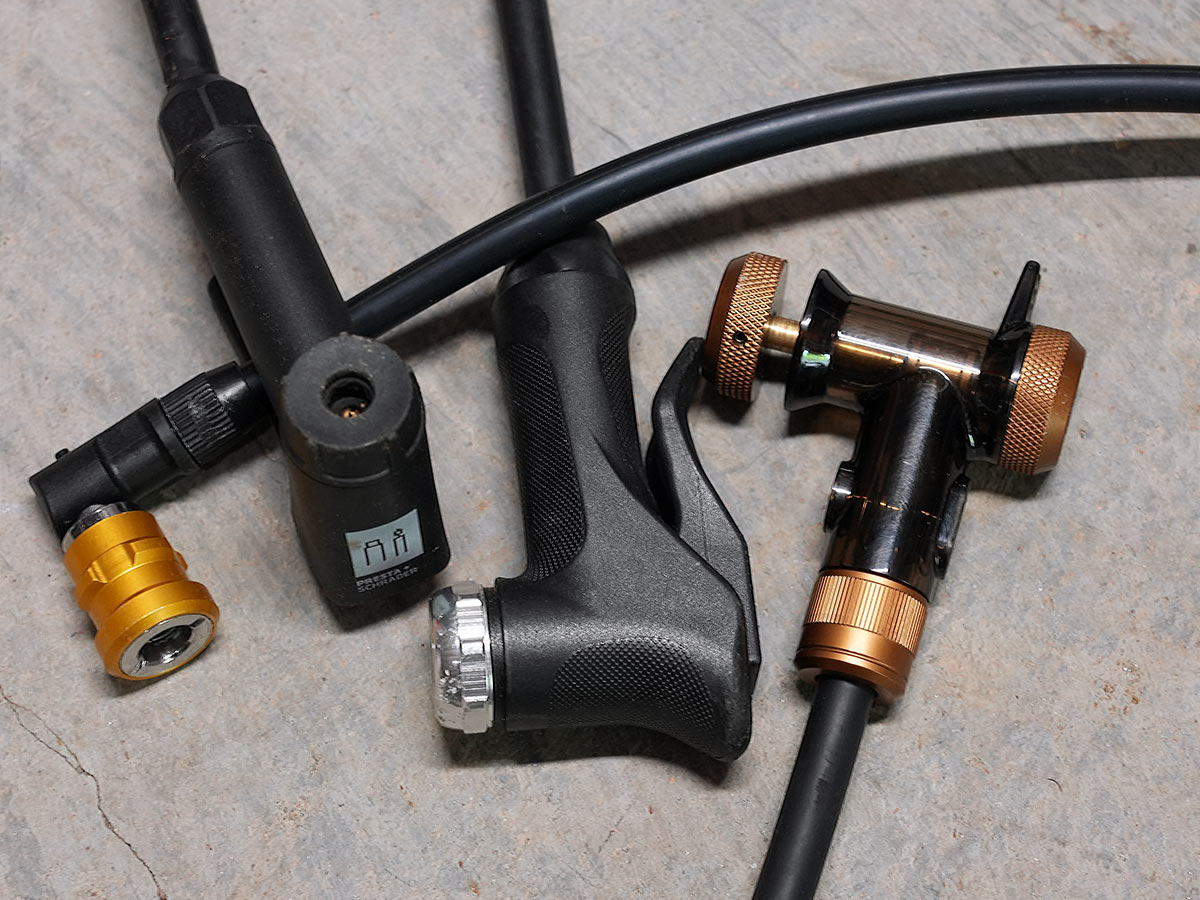
Secure Attachment and Ease of Use: These are the most important features of a bike pump. A pump that’s hard to attach to a valve isn’t just a hassle, it can also damage your valve. If you need to maneuver your valve around and are pushing and pulling it in all directions, that can potentially weaken the seal between the valve and the rest of the tube and cause a leak…or break it altogether. And if the attachment isn’t secure, you’ll get halfway through pumping a tire only to have the inflator pop off.
Speed of Inflation: Most pumps should take under a minute to fully inflate a tire, and topping off a tube that’s just a little soft should only take a few pumps. Still, you don’t generally want a pump that could inflate a tire to 100 PSI in just three pumps, because most riders will prefer to dial in their tire pressure to a specific PSI.
Stability & Comfort (how comfortable is it to use): The most important part of the pump when it comes to comfort is the handle. The wider it is, the easier it will be to use, though it becomes more cumbersome to store. And funny enough, height matters. Some pumps will be optimal for taller people, while some are better designed for short riders. (This generally won’t be a major issue, and most pumps are very similar in height, just something to be aware of.)

Durability: Typically, pumps made with metal bodies –both floor and mini-pump models- will be more durable than their plastic counterparts. They’ll also be easier to fix if a small part does break. Even handle material can play a role in a pump’s longevity: The cheaper models with lightweight plastic handlebars are prone to feeling as though they’re bending as you pump and can even break, which can be dangerous if it happens mid-pump. All of the pumps we’ve recommended here have handles that have lasted through thousands of pumps (often in a hurry) and have proven to be solid.
Value/Price: Opt for brands you’ve heard of, and don’t get the cheapest option out there. There are thousands of cheap knockoffs available online, but often, they have small pieces that will break or become detached at a critical moment—or the description won’t be clear and you’ll end up with a pump that only inflates Schrader valves when you’re running Presta tubes. Established brands like Silca, Lezyne, Birzman, Topeak, Bontrager, Specialized and Blackburn will generally have replacement parts and good warranties in place if something goes wrong. That’s also why they tend to be a bit pricier than no-name brands, but often, it’s worth paying more for a pump that can last a long time.
Frequently Asked Questions about floor pumps
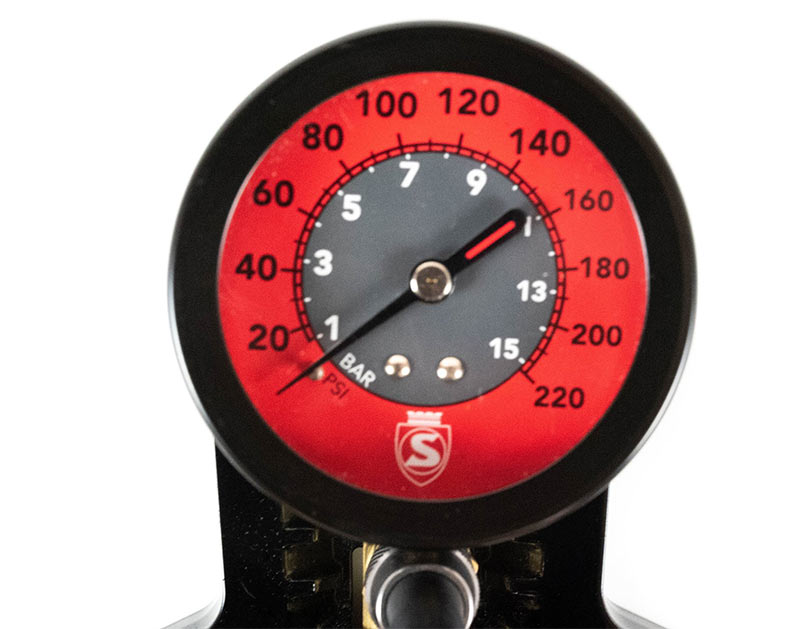
Why do some gauges go so high? Does anyone pump to 220psi???
Well, some track racers do pump their tires to 160psi or more, but that’s only because they are riding on a perfectly smooth surface in a controlled environment. Regular riding outdoors, on real roads and trails, needs far less tire pressure.
Recently, and especially with tubeless tires becoming the norm, it’s been proven that lower tire pressures yield more comfort, better traction, and improved efficiency. Yep, lower really is better. Brands like Silca have even made guides to help you find your best tire pressure.
So, why do floor pump gauges read so high? Because they need to account for the pressure spikes that occur when pumping. Next time you’re inflating your tire, notice how the needle spikes really high on each stroke. The gauge needs to have room for those spikes or it can be damaged, which means it will no longer be accurate. Specifically, they need 20-30% extra in order to safely cover the higher pressures generated during your pump stroke.
Using the Birzman Fatty as an example, if you’re regularly pumping your mountain bike tires to 22psi, then you need to upgrade to a pump whose gauge has a higher maximum pressure. That’s why we recommend the SKS pump for mountain bikes and gravel bikes even though you’re (hopefully) never going to pump either anywhere near 70psi!
Do you need a floor pump and a mini pump?
When you’re out on your ride, if you do end up with a flat tire you’re going to want a mini-bike pump on hand to fix your flat. But while a mini-pump can inflate your tires in a pinch, they generally require around 300 pumps just to get your tire to the point where it can roll you home safely. You wouldn’t want to use one of those every day, and you would never achieve optimal tire pressure using a mini-pump to inflate a tire. That’s why you also need a floor pump, which can top off your tires with just a few pumps.
What tire pressure should I run?
It depends on the type of bike and tire you’re running. All bike tires will have a recommended PSI range listed on their sidewalls, so try to stay within that range. For most road riders, pumping tires to between 80 and 90 PSI is a good starting point, while mountain bikers will run anywhere from 18 to 35 PSI depending on the rider’s weight and the terrain.
How often do you need to pump up tires?
Don’t wait for your tire to be flat before you add air to it. This reporter made that mistake early in her cycling career and ended up crashing in a road race because her tire was so low on air that it collapsed in a corner and the whole bike followed. Before you head out on any ride, do a quick test of your tires by pressing your thumb down on the center of the tire. If you’re riding a road bike, they should feel hard, like an apple. If you’re riding a mountain bike, you’re looking for a bit more give, similar to what you would feel if you pressed on an orange. You may only need to add air every few days, but check each time you ride to save yourself from an untimely flat.
Will these bike pumps work on all bikes?
Assuming the bike’s tube has a Schrader or Presta valve and your pump has the Presta or Schrader attachment (most have both), you’re in luck. Schrader valves tend to be found on most inexpensive bike models—the kind you get at department stores—and are also found on car tires. Presta valves are found on most higher-end bike models and road bikes. Schrader valves are the wider of the two, while Presta valves are thinner and have a small nut at the top that needs to be unscrewed before you can inflate the tube.
How long does a bike pump last?
This depends a lot on the bike pump that you buy: Some are made with cheap plastic and you’ll be lucky to get a season of use out of them, while others—typically made with aluminum or steel—can last for decades. But assuming you buy one from this list of bike pump reviews and nothing untoward happens to it (like a puppy gnawing on the hose), a pump should last for a long time.
What features should you look for in a floor pump?
If you’re looking for a pump at a bike shop and can’t find one from our list above, keep an eye out for these key features that make up a solid floor pump:
- Sturdy handle
- Metal body
- Gauge that’s easy to read
- Long enough hose (should go over handle and at least halfway down the side of the pump)
- Wide enough base for your feet to hold it in place
- Pump head that’s easy to use for the type of valve that you have on your tubes (Presta or Schrader, or a combination pump head if you regularly inflate both) and that locks onto the valve (either by screwing on or snapping on)
- Replaceable parts in case of breaks (or a warranty)
It’s OK to ask the store if you can test the pump before you buy, just to see how the pump head works and how the actual pumping motion feels. They should have plenty of bikes there for you to test it on!
What’s the difference between a High Pressure pump and High Volume bike pump?
High-Pressure pumps are designed to inflate tires to higher pressures, usually road bike tires. They move less air per stroke, but they remain easy to pump even at really high pressures.
High Volume pumps move more air to fill high volume tires. They remain easy to pump up to about 30-35psi, but then become exponentially harder with each additional push. So, they’ll fill big tires fast, but you’d get a serious workout trying to inflate a road bike tire.
This, along with getting a gauge that’s as narrowly ranged as appropriate for the intended use, is why we recommend different pumps for different types of bikes. Yes, you could just buy one of the budget or mid-range items, but more advanced riders will want to eke out every marginal gain they can by having finer control over their tire pressure.
